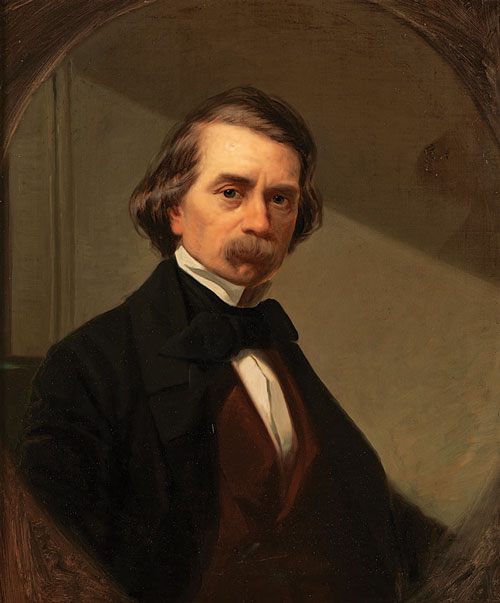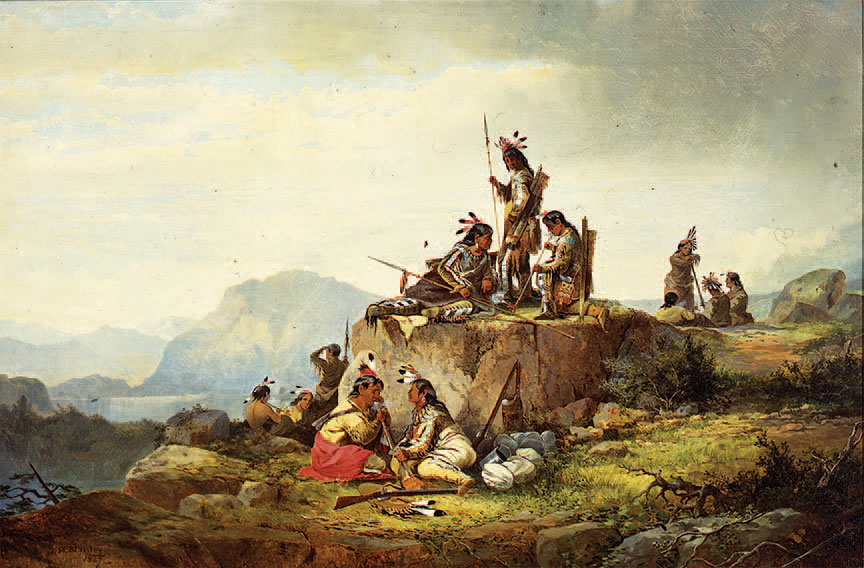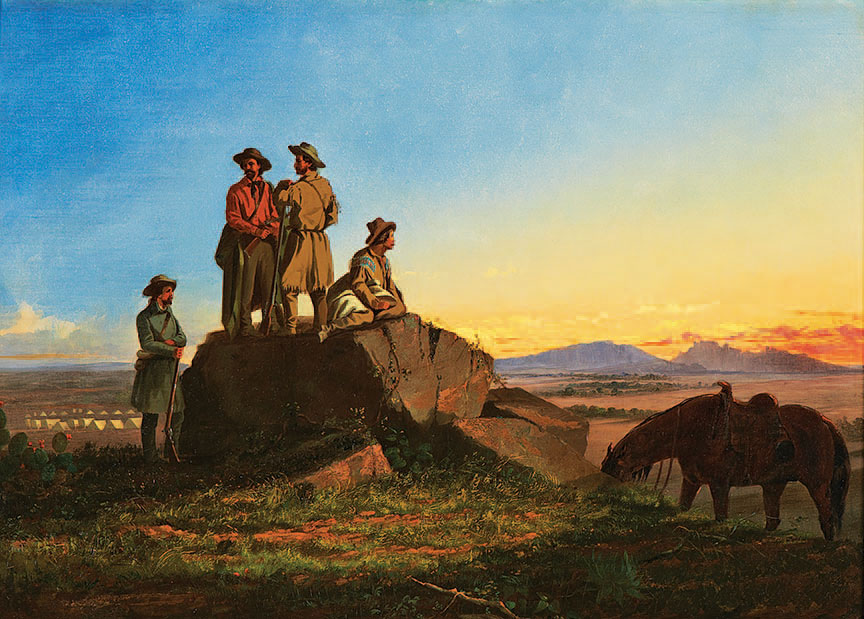Relatively unknown but a giant of Western art, John Mix Stanley, the unsung 19th-century painter of Native Americans, is finally receiving a long-overdue retrospective exhibition.
Prolific artist John Mix Stanley traveled many thousands of miles through the western territories painting portraits of American Indians. He made the rounds with his artwork in popular traveling exhibitions attended by as many as 1,000 people a day. And his North American Indian Gallery hung prestigiously in the Smithsonian Institution. In his day, he was viewed as the premier painter of Native Americans. But today his name is relatively unknown, in part because the majority of his works were destroyed.

After devoting his life to authentically presenting Native Americans in fine art, Stanley lost most of his paintings in a catastrophic fire that nearly leveled the Smithsonian. The New York Times published a story about the tragedy, datelined Washington, Tuesday, January 24, 1865: “This afternoon, about 3 o’clock, a fire broke out in the Smithsonian Institute building, in the loft above the picture-gallery, between the ceiling and the roof, caused, it is believed, by a defective flue. The ceiling soon fell in, and in a few moments the gallery was one sheet of flame. ... The windows of the picture-gallery soon burst out, disclosing only the shell of the room. There were some two hundred of STANLEY’s pictures here. He had negotiated for their sale to the Michigan University. Only five or six of them were saved. The loss is very serious. ...”
Workmen had been tasked with rearranging paintings in the Indian Gallery, which was hung floor to ceiling with original portraits of Native Americans primarily by Stanley and Charles Bird King. It had been a bitterly cold winter, and two workers had temporarily installed a stove to keep warm, running a stovepipe to what they mistakenly thought was an exhaust flue. A few days later, smoldering behind the wall caused the great sandstone building to go up in flames. Even as a portion of the ceiling was caving in, employees tried to remove paintings from the walls. Although a half-dozen or so were saved, more than 200 were unrecoverable — lost was “the most valuable collection in existence of illustrations of the features, costumes and habits” of Native Americans, wrote the Smithsonian’s first secretary, Joseph Henry.
“The Apparatus room, the picture gallery, the Regents room & lecture room were destroyed,” Henry’s daughter recorded in her journal. “I went this morning to visit the scene of destruction. All Smithson’s personal effects; all Dr. Hare’s philosophical apparatus, the Stanley Indian Gallery of portraits have all perished. We entered the Apparatus room first. The dismantled walls & towers rose high above us reminding us of the ruins of some English Abbey. ... We picked our way over the cinders & burnt bricks through the lecture room to the Picture Gallery. The remains of the dying gladiator lay scattered about — we picked up a few pieces but they crumbled in our fingers. ...”
So it was with a certain literal flair that 150 years later a press release headlined “Rediscovered: An Artist’s Legacy Rises From the Ashes” announced the first major exhibition comprehensively covering Stanley’s work. Organized by the Buffalo Bill Center of the West, Painted Journeys: The Art of John Mix Stanley finally gives the artist his due. Co-curated by Peter H. Hassrick, director emeritus and senior scholar at the center and director emeritus of the Petrie Institute of Western American Art at Denver Art Museum, and Mindy N. Besaw, curator at the Crystal Bridges Museum of American Art in Bentonville, Arkansas, the groundbreaking exhibition featuring 60 key works is on view at the Tacoma Art Museum in Tacoma, Washington, January 30 – May 1. Cowboys & Indians talked with Hassrick about the exhibit, the painter’s heartbreaking loss, and his rediscovered legacy.
Cowboys & Indians: Put Stanley in his historical Western context for us.
Peter H. Hassrick: Stanley was born in 1814, grew up on the western boundary of Troy, New York, and began his career as an itinerant portrait painter in Detroit. He first came West in 1842, traveling through Indian Territory and the Far West, which gave him the impetus to build and create an Indian Gallery of portraits and scenes of Native people and their life ways in order to preserve and enrich their legacy. Over the course of 15 years, Stanley found many opportunities to head West. He traveled the Santa Fe Trail and joined up with Gen. Stephen Kearny’s Army of the West’s march toward California and served as the official artist. Stanley wandered through Minnesota and Washington territories as a member of Isaac Stevens’ Pacific Railroad survey expedition. He even sailed to Hawaii, where he had the opportunity to paint the portraits of the then-king and queen. Remember, his travels in the West came during contentious antebellum times of competing regional interests. There was a burgeoning national desire for westward expansion, and he had to navigate the many sectional divides and attitudes.
C&I: Stanley’s described as an artist-adventurer — what did that hyphenation mean in his era?
Hassrick: He probably traveled more in the West than any artist of his day. There was a certain sense of being especially American by being an adventurer — venturing out into the unknown parts of America. Stanley was revered for that quest for adventure as well as his capabilities in the studio. He was a restless man full of wanderlust who did not see himself sitting in the studio painting fancy people. The Indian became that invitation to adventure. Two years in a row he went into Indian Territory, to the Brazos River in Texas and to Louisiana. He gets back in the saddle and goes along the Santa Fe Trail. Conscripted into the Kearny expedition, he gets all the way to San Francisco as a member of that expedition. After arriving there, he starts off on his own — 300 miles up to the Columbia River and back down to San Francisco. Then he travels off to Hawaii for a year and back home in 1850. On his return, he paints his Indian Gallery and takes it around the country, ending up in 1852 in D.C., where he’s turned down by Congress when they decline to purchase his work. The very next day he’s on a survey for the railroad. He was on the farthest north expedition with Isaac Stevens, the new governor of Washington Territory, as the official artist. He came back, got married, and never traveled again. That’s a lot of mileage. Mind you, this was all before there were trains in the West — all this travel was by horseback.

C&I: Why didn’t Congress buy his gallery?
Hassrick: He tried three times to get his Indian Gallery purchased. But purchasing it would have required Congressional appropriations, and that wasn’t going to happen, mostly because of the South and earlier Indian removal. The Jackson administration had cleared the Indians out and moved them forcibly to present-day Oklahoma. Having done that and taken Indian lands in order to expand the slave culture and cotton empire, they did not want the Indians to be particularly aggrandized. If the nation purchased the paintings and celebrated this Native culture, Southerners were afraid there might be some recrimination coming back on slavery and the decision to remove the Indians from their indigenous lands. The vote whether or not to purchase Stanley’s Indian Gallery came down to Jefferson Davis, and he voted no. It’s a powerful story of divisions and sectional divide, based on trying to salve the guilty conscience of the Jackson administration for the removal of the Indians from their homelands in the South.
C&I: Why isn’t he known as well as, say, George Catlin?
Hassrick: I think it’s a combination of the fire and the fact that before now there’s been no great exhibition of Stanley’s work. Both of Catlin’s major bodies of work are preserved in major institutions in the nation’s capital. Stanley lost all except seven pieces in the Smithsonian fire. So the heart of his life’s work was destroyed. In the 1940s, there were two exhibitions of his known work — one in Michigan and one at the Smithsonian. And there was a small publication done on him after World War II. Other than that, there hasn’t really been a venue for his work or focused attention on him. Dr. Julie Ann Schimmel, to whom the book and exhibition are dedicated, did her dissertation on Stanley in 1983. Her years of study and contribution were brought to bear as the heart of scholarship on which we depended for the book and exhibition. So then it was a matter of a serious institution taking hold and sponsoring Stanley in a public way. The Cody museum has now done that.
C&I: How were you able to pull a major show together when so much of Stanley’s work was destroyed?
Hassrick: The Indian Gallery in its various iterations was very popular. He took it around the country, and there’d be a thousand people a day coming through to see it. It provided a little income and a lot of patronage. People asked for commissions, so he would paint alternate versions. There are photos of the Indian Gallery as it was hung in the Smithsonian. There were different versions of the paintings — he did multiples. He continued to paint variations on the themes. Fifty-three watercolors at Yale [University Art Gallery] survive — that’s almost a quarter of the body of work we know about, all in that one collection. After the Smithsonian fire, Stanley continued his quest to paint the West and its inhabitants and attempted to rebuild his gallery in various forms. In terms of documenting his work, Dr. Schimmel included a checklist of his extant work in her dissertation and had done a lot of the groundwork; then while working with Gerald Peters, she continued to authenticate. That became the basis for both the show and the book.
C&I: What is artistically important about Stanley’s work?
Hassrick: He stressed, in presenting himself and in presenting his work, that these were works of fine art. George Catlin always apologized for not being a great painter — he blamed the exigencies of time and travel. But Stanley never got into that. His stance was, I am assembling a gallery of fine paintings that represent the Indian in the best possible light. Catlin was motivated very much by science — the discipline of documenting absolutely everything in order to understand the world. Stanley couldn’t care less. His motivation was to find great Indian people, major tribal figures, and paint them in the most distinguished and artistic way possible.

C&I: You’ve called the story Stanley tells about Native Americans “compelling and complex.” How so?
Hassrick: The complexity is that he’s an artist and has to make a living and accommodate taste and expectation. Through the course of his life, he’s trying to give a celebratory pictorial face to Native people. But he watches as the national appreciation for Native people diminishes. They first are a national symbol but are then replaced by Anglo figures. Stanley’s caught in between. One of his paintings is called A Family Group [alternately titled Barter for a Bride]; it belongs to the U.S. Department of State. It shows a family of Native people at the apex of their world. They’re prosperous, working together in a beautiful unspoiled landscape. Water flowing symbolizes regeneration and rebirth — there is an ethnic continuity that they would continue. The same year he paints The Last of Their Race to accommodate people who would just as soon see the Indians go away and not have an Indian problem anymore — there was an increasing appetite for that. So he shows the Indians pushed to the Pacific Ocean. Stanley’s working both crowds. He’s got to make a living. On the one hand, he’s defending his own image of Indian people as healthy American citizens, survivors, real people. On the other, he seems to be commodifying the Indian in a popular way.
C&I: You’ve commented that Stanley died of a broken heart. ...
Hassrick: He died of a heart attack in 1872 at age 58. I haven’t seen the medical report, but obviously, broken-hearted is a metaphor — it’s probably the way he felt. He survived the fire, which happened when he was 51, but his work didn’t. You can see from images of him in his later years he looks very stressed. He’s trying to recoup his fortunes. His life investment was in those collections. He was not compensated at all by the government — not by anyone. He had borrowed against the collection from the secretary of the Smithsonian, Henry, and had to use five of the seven surviving paintings to pay him off.
C&I: This exhibition should go a long way in helping Stanley take his rightful place in Western American art. What is his place in the canon?
Hassrick: He becomes one of the great painters of Indian people. He gives them a pictorial face, a positive place. He does it with the best work he’s capable of. He was basically self-trained. He was not as accomplished as some people who studied in Europe, but he was “accomplished” nonetheless. Giving a pictorial face to Indian people and celebrating their life ways was important, and he does this in a gentle way. With him you rarely see paintings that show a demonic Indian: on the warpath, vengeful, or ominous-looking. For him, they had a wonderful different culture and countenance. He presented them in his best possible artistic way — it’s really quite genuine, particularly as he matures in his career.
C&I: Does the painting you chose for the cover of the book exemplify that?
Hassrick: There’s an important comparison between that painting, Group of Piegan Indians, and another, Scouts Along the Teton River — they’re two of my favorite paintings, and they make for an ideal summation. In the latter, you have the Isaac Stevens expedition. He’s in a red shirt on top of a rock with a row of tents in the background. There is a sense of the ordered elements of progress. Some of the men are looking at the sunset; they are moving toward it, expanding westward. They stand on a pedestal and survey this land with the “magisterial gaze.” It’s a celebration of Manifest Destiny, expansionism, the imperializing spread of Anglo culture. He’s working for the railroad — it will bring progress and change to the West. So here you have celebratory Anglos on the horizon. Now compare that with the cover image. These are Indians. They are similarly looking down on nature in their command — they are in control of their world. The Indian painting shows Stanley’s ability to capture the human form and compose pictures in a classical way. For him, the Indians are just as important as the Anglo guy looking ahead to where he’s going to build that railroad. They are both on this plinth looking out. One Indian’s hand is out just like one of the Anglo explorers. The Indian is surveying his domain (we’re pretty certain it’s what is now Glacier National Park). The Blackfeet Indians in that painting couldn’t care less about the Anglos. This is their world. But right across the horizon ... .
For more information about the exhibition Painted Journeys: The Art of John Mix Stanley, visit www.tacomaartmuseum.org.
From the February/March 2016 issue.














